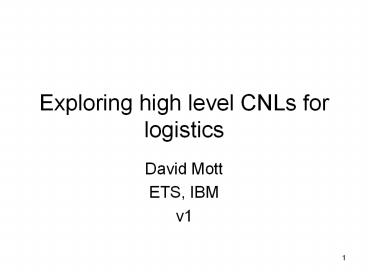Exploring high level CNLs for logistics - PowerPoint PPT Presentation
1 / 12
Title:
Exploring high level CNLs for logistics
Description:
Evolving Design in visualisation prototype. What do the yellow areas mean? ... verbose, awkwardness, generic. LOW. HIGH. 6. Approach ... – PowerPoint PPT presentation
Number of Views:45
Avg rating:3.0/5.0
Title: Exploring high level CNLs for logistics
1
Exploring high level CNLs for logistics
- David Mott
- ETS, IBM
- v1
2
Evolving Design in visualisation prototype
What do the yellow areas mean?
How do I represent this in a CNL?
3
Basic Domain Concepts
this defines syntax of fires
4
How much resource is required?
Uses is really a table of resource usage rate?
- Want to say
- the AS90 uses the NATO_L15 for the bombardment at
a rate of 2 . - the AS90-39 uses the long range ERA for the
bombardment at a rate of 1 . - But this is not basic CE, it is a high level CNL
- Also might want to record the Table as OWL
entities
syntax of uses
5
What do I mean by higher level CNL?
HIGH
comprehensibility, elegance, succinctness,
specialist
the armoured unit A1 cannot be used for the
resource request R1
she run to tree and climb it
there is an act named 'CANT USE' that has the
armoured unit A1 as object and has the resource
request R1 as recipient object
girl run. reach tree. climb.
verbose, awkwardness, generic
LOW
- Higher levels add
- new function words, to, for,
- new (domain specific) logic words, cannot be
used for, after - new domain specific (or metaphor specific?)
abstractions of entities killer app
6
Approach
- Build a transformation language, defining how
high level is turned into low level CE - This language uses linguistic terms, eg (nounP)
- There must be a corresponding logical
transformation
7
Option A. Transform high level CNL into CE
entities
linguistic transformation rule
- Results in basic CE
- the resource usage ru1
- has the type AS90 as user type
- and has the type NATO_L15 as resource type
- and has the type bombardment as task type
- and has the constant 2 as rate .
like a table row
8
Use a generic CE rule to calculate the quantity
needed by a resource request
resource request and its components
resource usage table, giving rate
match to the correct row
calculate the qty from the task duration
Note the META attribute for type
resulting quantity for the resource request
Would be easier visualised as a graph
9
Option B) Transform the table directly into
implications
- The high level CNL
- the AS90 uses the NATO_L15 for the bombardment
at a rate of 2 . - Results in
- if
- ( the resource request RR is required by
the bombardment T ) - and ( the bombardment T has the AS90 A as
executor ) - and ( the resource request RR requires the
NATO_L15 R ) - and ( the bombardment T has the value D as
duration ) - and ( the value Q the value D the value 2 )
- then
- ( the resource request RR has the value Q as
quantity ) - .
request and its components
calculate the qty from the task duration
resulting quantity for the request
10
The Linguistic Transformation Rule
- Specific rule, one rule per row in the table
- Simpler but has no explicit table entities
- This is an AXIOM SCHEMA
- Template for an implication (transformation
rule) - a set of parameters (high level CNL instance )
- generates
- An instantiated implication (basic CE)
- This is a way of getting round the limitations of
First Order Predicate Logic
11
Comparison of Options
- Option A
- transform high level CNL into table row entities
- only need one generic rule to calc resource
requirement - need extra meta-machinery to represent types in
the transform rule (this is where the meta
miracle occurs) - Option B
- transform high level CNL into specific rules to
calc resource requirement - no explicit representation of table row
- many rules created
- no need for meta-machinery
- equivalent to axiom schema (this is where the
meta miracle occurs)
12
Where is the Logical Underpinning?
- I am creating logical implications, which have a
logical meaning - Option B uses axiom schema
- Option A uses meta miracle at the linguistic
level, this needs logically underpinning































